Ever felt cramped in a small bedroom but still crave a stylish, functional space? Small bedroom layout ideas are gaining popularity because they prove that smart design can maximize every inch, making even tiny rooms feel spacious and cozy.
In this article, you’ll find a variety of creative and practical layout ideas that can transform your small bedroom into a perfect sanctuary. From clever furniture placement to space-saving solutions, these ideas cater to different styles and needs, ensuring there’s something for everyone eager to optimize their space.
1. Maximizing Vertical Space with Tall Storage Units
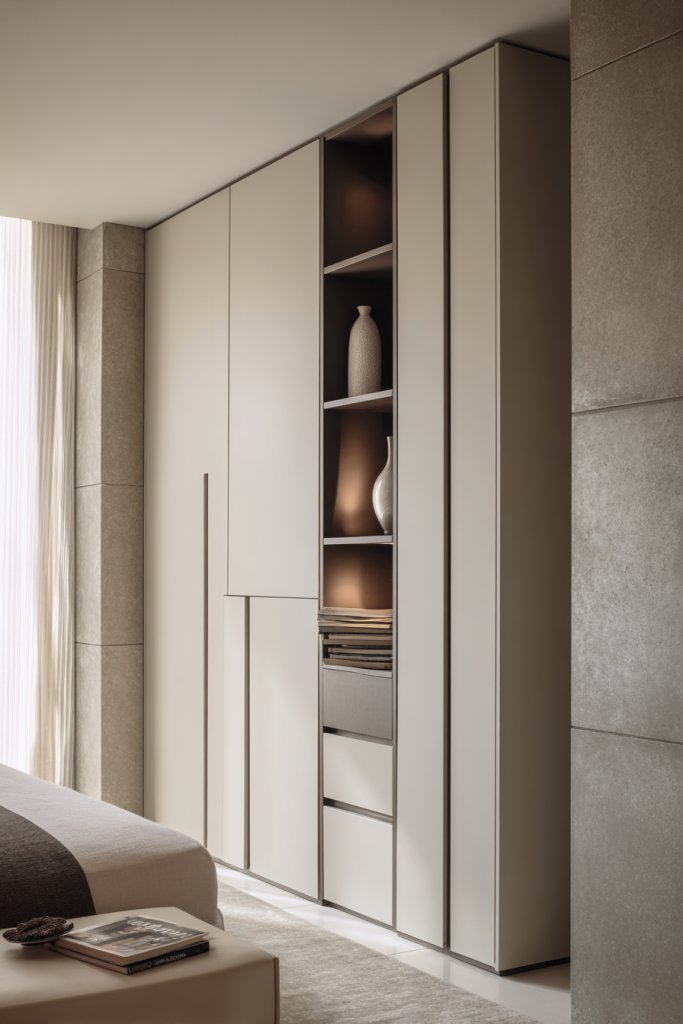
Ever feel like your small bedroom is fighting against you for every inch of space? Clutter piles up, and you’re left wishing there was a way to make your room feel bigger without sacrificing style. The idea of stacking up shelves or towering cabinets might seem daunting, but it’s actually a smart fix. Vertical storage can transform your tiny space into an organized haven.
Imagine floor-to-ceiling shelves filled with neatly arranged books, baskets, and decorative boxes. The warm wood finish contrasts beautifully with crisp white walls, giving an airy yet cozy vibe. Tall cabinets hide away seasonal clothing and extra linens, freeing up your closet. The overall look feels sleek, making the ceiling appear higher and the room more open.
Adjust your vertical storage to match your style—industrial metal shelving for an edgy look or painted wood for a softer feel. If you’re in a rental, consider freestanding units that won’t damage walls. For seasonal changes, swap out items on high shelves to keep the space fresh. Even in a tiny room, a mix of open and closed tall units balances accessibility and tidiness.
Start by measuring your wall space and selecting tall units that fit comfortably. Install sturdy wall-mounted shelves or opt for a freestanding tower that reaches the ceiling. Use brackets or anchors for safety, especially if you plan to store heavier items. Organize by category—books, decor, textiles—and label for quick access. Incorporate adjustable shelves for flexibility as your storage needs evolve. Regular decluttering keeps the space functional.
Add decorative touches like colorful baskets or textured storage bins to inject personality. Use matching containers for a cohesive look or mix textures for visual interest. Incorporate small LED strip lights underneath shelves to highlight your favorite items. Personalize with framed photos or travel souvenirs on the upper shelves to make the space uniquely yours. The key is blending function with your style.
Vertical storage is a game-changer for small bedrooms, turning vertical real estate into your best friend. It’s a simple upgrade that makes your room appear taller and more spacious instantly. Once you see how much extra space you gain, you’ll wonder why you didn’t do it sooner. Ready to elevate your room with towering storage? Your organized oasis awaits!
2. Incorporating Multi-Functional Furniture for Compact Living
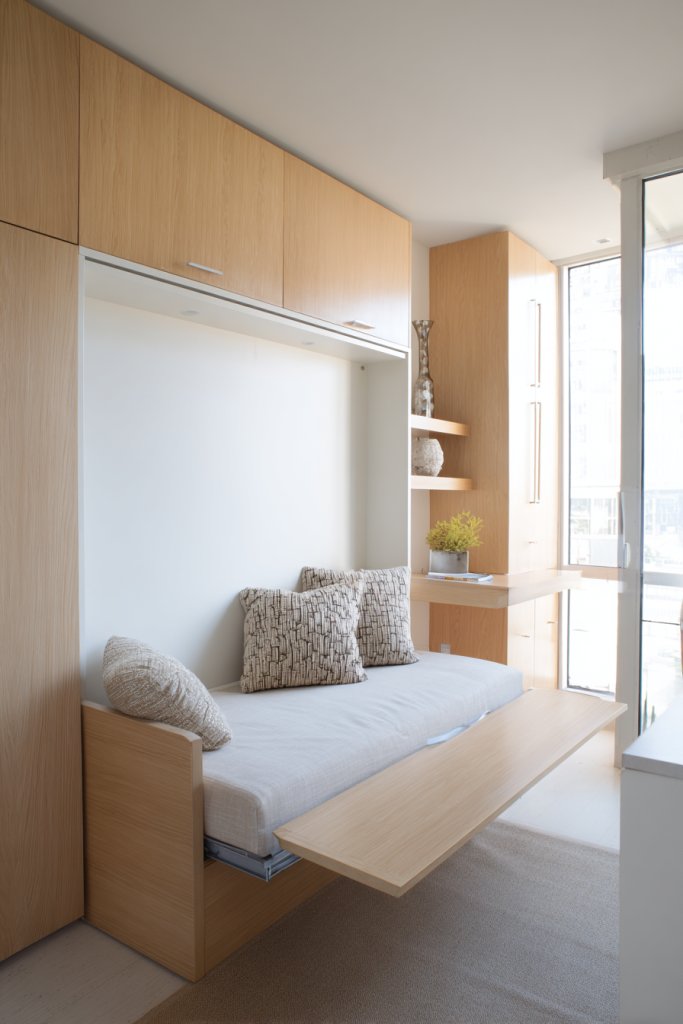
Living in a tiny space often means sacrificing comfort or style just to fit everything. But what if your furniture could do double duty? Multi-functional pieces are the secret weapon for maximizing limited square footage without feeling cramped. They’re perfect for small bedrooms that need to do it all.
Picture a sleek bed frame with built-in drawers underneath, perfect for stashing clothes or bedding. Or a fold-away desk that tucks neatly against the wall when not in use, freeing up valuable space. Imagine a stylish ottoman that opens to reveal a hidden storage compartment, doubling as seating and a place to stash extra pillows. These pieces keep your room looking clean and spacious.
Choose furniture that matches your aesthetic—minimalist, boho, industrial—so it seamlessly blends into your decor. For small studios, consider a sofa bed that transforms from a cozy lounge into a sleeping space. Multi-purpose beds with attached desks work well for students or remote workers. Use wall-mounted foldable tables for dining or work, especially in very tight spots.
Start by assessing your primary needs—sleeping, working, storage—and selecting furniture that covers multiple bases. Look for beds with integrated storage drawers or lift-up mattresses. Install wall-mounted desks or fold-down tables that can be tucked away when not in use. Use lightweight materials for easy rearrangement and cleaning. Prioritize quality to avoid quick wear and tear. Keep pathways clear by choosing sleek, space-saving designs.
Customize with decorative elements like colorful cushions or textured throws that enhance the multi-functional furniture’s look. Add a few wall hooks or magnetic strips nearby for organizing accessories or tech gadgets. Use removable adhesive strips to attach small shelves or clips for extra storage. Play with different arrangements to find what best fits your daily routine and style. The goal is functional versatility with personal flair.
Multi-functional furniture turns your small bedroom into a versatile, clutter-free retreat. It’s a smart, stylish way to make the most of every inch. Once you see how easily these pieces adapt to your needs, you’ll wonder why you ever settled for less. Embrace the freedom of flexible living—your space will thank you!
3. Creating the Illusion of Space with Light Color Palettes
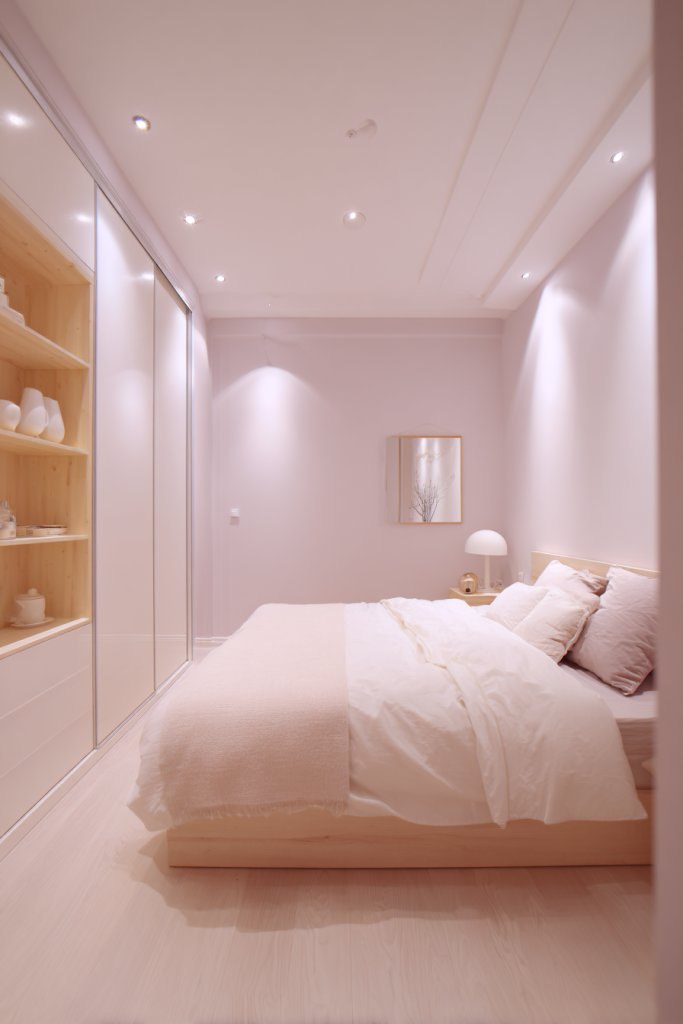
Got a tiny bedroom and feeling like it’s closing in on you? Dark walls and heavy furniture can make a small space feel even smaller. Luckily, choosing the right color palette can trick the eye into perceiving more room. Light colors are your secret weapon for creating an airy, open vibe.
Think of soft pastels or neutral shades like beige, blush pink, or icy blue painting your walls. These hues bounce light around the room, making it feel brighter and larger. Pair with crisp white furniture or bedding to enhance this effect. Reflective surfaces like glossy finishes or subtle metallic accents amplify the sense of openness. The overall palette creates a calm, spacious atmosphere that invites relaxation.
Adjust your color scheme based on your style—cool tones for a tranquil retreat, warm neutrals for cozy comfort. Seasonal shifts can be as simple as changing bedding or decorative textiles in similar shades. Darker accents, like navy or charcoal, work well for headboards or curtains to add depth without overwhelming. For a more eclectic look, combine different shades of light colors with subtle patterns.
Start by painting your walls with light, matte finishes that reflect rather than absorb light. Use light-colored flooring or rugs to extend the sense of space. Keep furniture in neutral tones—avoid heavy, dark pieces that can weigh down the room visually. Incorporate sheer or light-filtering window treatments to maximize natural light. Keep clutter minimal to let the light and colors breathe freely. Regularly clean surfaces to maintain brightness.
Introduce soft textiles like linen or cotton curtains, bedding, and throws in pastel shades to add warmth and texture. Use decorative pillows with subtle patterns or tonal embroidery for visual interest. Incorporate small metallic or glass accents, like picture frames or hardware, to catch the light subtly. Personal touches like framed quotes or artwork with light backgrounds also help maintain that spacious feel.
A light color palette doesn’t just make your room look bigger—it transforms your mood too. It creates a peaceful environment that can help you unwind after a long day. Once you embrace these colors, you might find yourself spending more time loving your space. Bright, open, and inviting—who wouldn’t want that?
4. Using Mirrors Strategically to Double Perceived Space
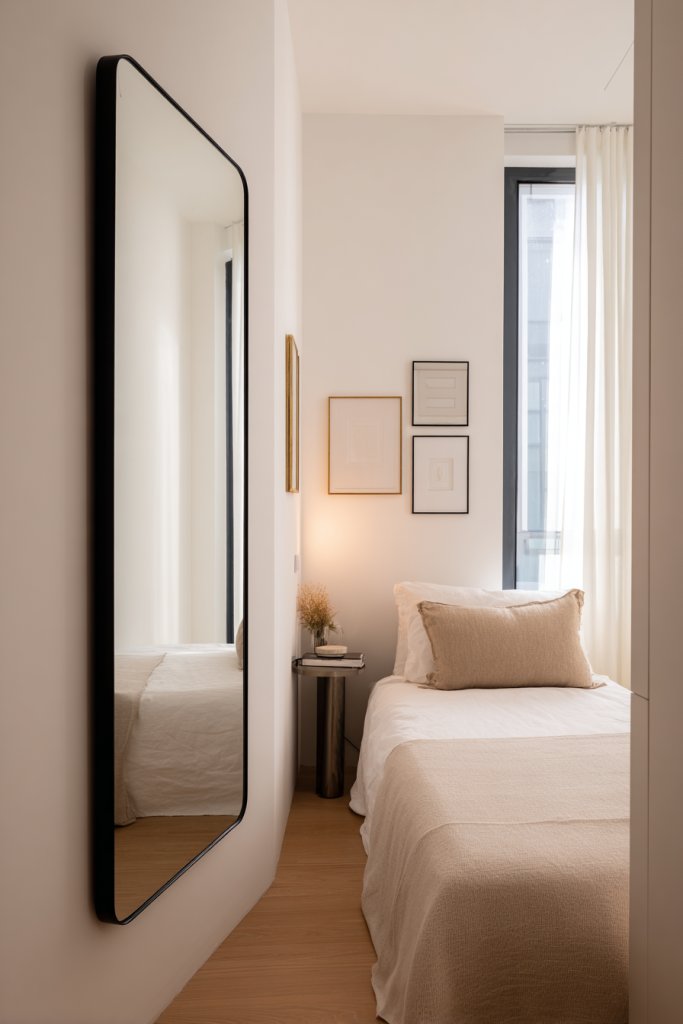
Feeling boxed in by your tiny bedroom? Mirrors are the ultimate optical illusion tool for expanding space without any major renovations. Placing a well-placed mirror can instantly make your room feel twice as big and bright. It’s a hack that’s been used in design for ages, and for good reason.
Imagine a large wall mirror reflecting your room’s window and light, creating a sense of depth and openness. Mirrored wardrobe doors can hide storage while doubling the visual space. The reflective surface bounces daylight, making your small room feel airy and less confined. A strategically angled mirror can also highlight artwork or decorative details. The effect is a seamless extension of your space.
Use full-length mirrors for practicality and style, or opt for decorative framed mirrors to add personality. Place mirrors opposite windows to reflect natural light or near light sources like sconces or candles. Consider using multiple smaller mirrors grouped in a gallery style for a modern touch. The key is balancing reflection with aesthetics—avoid overcrowding.
Choose a mirror size that fits your wall space and style. Secure heavy mirrors with proper hooks or brackets to prevent accidents. Position mirrors at eye level or slightly above to maximize their impact. If you have a closet, install mirrored doors to save space and add function. Regularly clean the reflective surface to keep glare and reflections crisp. Be mindful of lighting to enhance the mirror’s effect.
Frame your mirrors with decorative trims or paint the edges to match your room’s palette. Add a few small accent lights or LED strips around the mirror for a glow effect. Use mirrors to showcase interesting textures or architectural details behind them. Play with different shapes—round, oval, or geometric—for a unique style statement.
Mirrors are more than just practical—they’re transformative. They make your space appear larger and more inviting with minimal effort. Once you see how a simple mirror can redefine your room, you’ll wonder how you ever lived without one. Bright, spacious, and full of character—that’s the magic of a well-placed mirror.
5. Implementing a Floating Bed for a Modern, Open Feel
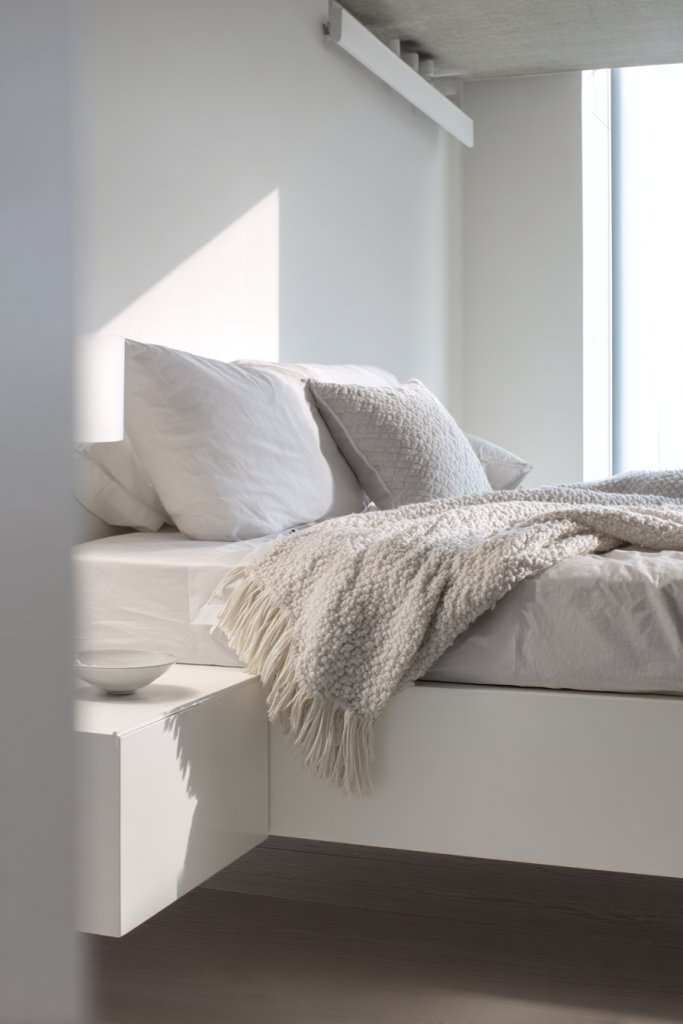
Small bedrooms often feel cluttered because of bulky furniture and heavy beds. A floating bed creates an illusion of more space by appearing to hover above the floor. It’s a sleek, modern solution that instantly lightens the room’s visual weight. Plus, it adds a touch of luxury without breaking the bank.
Envision a bed mounted directly onto the wall or on a minimalist platform with hidden supports. The space underneath remains open, perfect for small storage bins or cozy rugs. The clean lines and simple design give your room an airy, uncluttered vibe. Soft lighting beneath the bed adds a subtle glow, emphasizing its floating effect. It’s like having a piece of modern art in your bedroom.
Choose a floating platform in materials like wood, metal, or a combination to suit your style. For an industrial look, go for raw steel or concrete finishes; for a softer aesthetic, opt for wood or upholstered frames. Incorporate built-in LED lighting or under-bed lamps for mood lighting. This concept works well in both minimalist and eclectic interiors, adapting easily to your taste.
Start by selecting a wall-mount bed frame designed for easy installation. Reinforce the wall with sturdy anchors and ensure it can support the weight. Keep the area underneath free for visual openness or functional storage. Use a platform design that allows airflow, preventing moisture buildup. Finish with neutral bedding and minimal accessories to enhance the floating illusion. Regularly check the mounting hardware for safety.
Add textured bedding or layered textiles to soften the look. Incorporate small wall-mounted shelves or art around the bed for a personalized touch. Use ambient lighting like strip LEDs or spotlights to highlight the floating feature at night. Play with colors and finishes to match your overall decor theme—metallic accents, matte black, or natural wood.
A floating bed transforms a small space into a sleek retreat, making it feel more spacious and contemporary. It’s a bold choice that often sparks compliments and conversation. Once installed, you’ll enjoy a bedroom that feels open, modern, and uniquely yours. Ready to elevate your sleeping space to the next level?
6. Designing with Zone Layouts to Define Function Areas
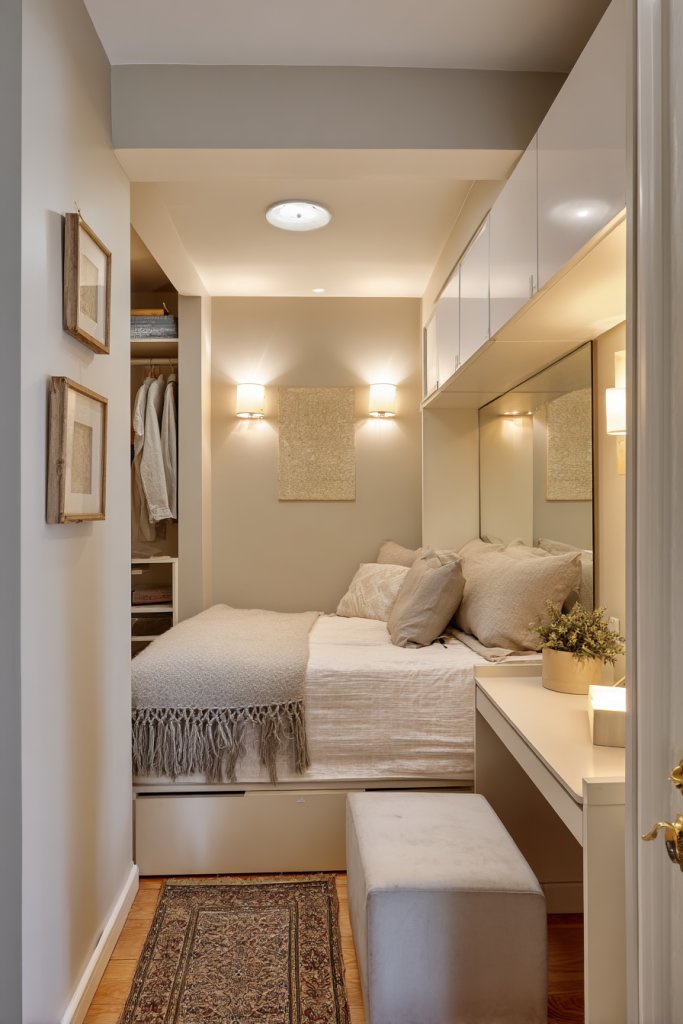
In tiny bedrooms, every square inch counts. Without clear zones, the space can feel chaotic and cramped. Designing with distinct areas for sleeping, dressing, and working helps organize your room and makes it feel more spacious. It’s about creating a flow that separates functions without walls.
Visualize a small room divided by a plush rug defining the sleeping zone, while a small corner is dedicated to dressing with a sleek wardrobe or open shelving. A compact desk in another corner becomes your workspace, separated with a fold-down or extendable surface. Using furniture placement and rugs creates visual boundaries that don’t block off the space. The overall effect is a tidy, purposeful layout.
For a minimal look, use color and texture to delineate zones—different wall colors or accent walls can define each area. In a budget setup, strategically placing a large rug or a low bookshelf acts as a divider. You can also use curtains or screens if you want flexible, temporary separation. Seasonal accessories, like cozy throws or decorative pillows, help reinforce each zone’s identity.
Start by sketching your room layout, placing furniture in a way that naturally creates distinct zones. Use rugs to anchor each area, and position furniture to facilitate easy movement. A foldable or wall-mounted desk can serve as a dedicated workspace that can disappear when not needed. Keep pathways clear and avoid clutter to maintain the illusion of space. Add small storage solutions to keep each zone tidy.
Introduce decorative elements like throw pillows, textured blankets, or curtains that match each zone’s mood. Use different lighting—soft ambient lights for the sleeping area and task lighting for the workspace—to make each zone functional. Personal touches like framed photos or artwork can personalize each space and make it inviting. Flexibility is key, so opt for adaptable furniture that can shift with your needs.
Designing with zones turns chaos into calm, making your small bedroom feel bigger and better organized. It helps you mentally separate work from rest, boosting productivity and relaxation. Once you master this layout, every inch of your room will serve a purpose. It’s a smart way to make tiny spaces feel expansive and personalized.
7. Choosing Compact Bed Sizes and Streamlined Frames
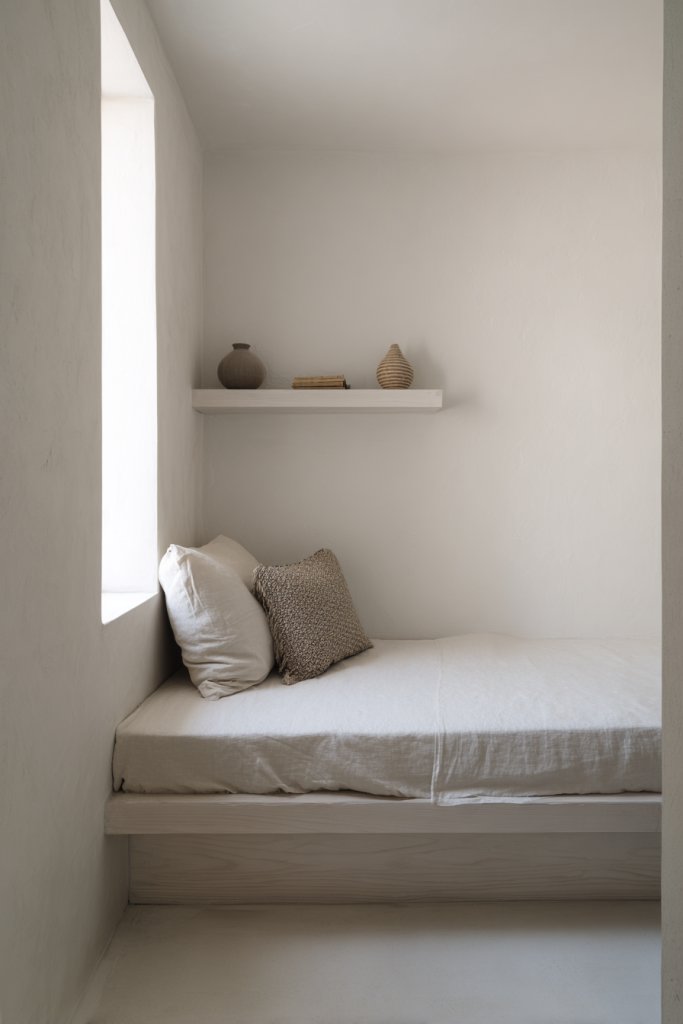
A bulky, oversized bed can swallow up a small bedroom, leaving little room for anything else. Opting for compact bed sizes like twin or full helps maximize open space and makes the room feel less crowded. Streamlined frames add to the airy vibe, making your space look and feel bigger.
Picture a sleek twin bed with a minimalist metal frame, positioned against a wall painted in a light neutral tone. The bed’s simple design leaves plenty of room to move around. Crisp, fitted bedding in soft shades enhances the sense of openness. The absence of bulky headboards or footboards allows the eye to travel freely across the room, creating a calming, uncluttered look.
Choose low-profile frames or platform beds without bulky legs, which keep sightlines open. For a slightly larger bed, opt for a full or queen size if space allows, but prioritize slim headboards or none at all. Use storage beds with built-in drawers to eliminate additional furniture. Decorating with light-colored bedding and minimal accessories maintains the streamlined aesthetic.
Measure your room carefully to select the right size that fits comfortably without blocking pathways. Look for beds with clean lines and simple hardware or no hardware at all. Keep surrounding furniture minimal—think slim nightstands or wall-mounted shelves. Use light, breathable textiles for bedding to enhance the open feel. Regularly clear out excess clutter to preserve the sleek look.
Personalize with cozy textiles like a soft cream throw blanket with chunky knit texture or subtle decorative pillows. Add a few wall-mounted art pieces or photo displays that don’t clutter surfaces. Incorporate ambient lighting like wall sconces or LED strips to highlight the bed’s clean lines. Keep decor sparse but meaningful for a timeless, elegant vibe.
Choosing the right bed size and frame can dramatically change your room’s vibe, making it feel more spacious and restful. It’s a simple switch that offers big visual payoff. Once you see how much more open your room becomes, you’ll be inspired to keep the space uncluttered and stylish. Small rooms can be big on comfort and style—just pick the right bed!
8. Utilizing Under-Window Nooks for Cozy Storage or Seating

Struggling to find space for extra storage or a comfy spot to read? Windows often become overlooked areas that can be transformed into functional and cozy zones. Using under-window nooks for storage or seating maximizes space and adds charm. It’s a clever way to make every inch work for you.
Imagine a built-in bench with a plush cushion nestled below a large window. Shelves or drawers hide away books, blankets, or shoes, keeping clutter out of sight. The soft fabric of the cushion invites you to sit and relax, while the natural light streaming in makes the nook a favorite spot. Decorative pillows or throws can add personality and comfort to this cozy corner.
Choose a simple wooden or painted built-in for a clean look, or add a touch of upholstery for extra softness. Use baskets or decorative boxes underneath for versatile storage. This setup works well in different styles—from rustic to modern—by altering the finishes and textiles. It’s also adaptable for small or large windows, fitting many room sizes.
Start by measuring the space beneath your window to plan your built-in or standalone bench. Use sturdy materials like wood or MDF, and finish with paint or stain that complements your room. Install the seating platform securely, ensuring it’s level. Add a comfortable cushion, and incorporate hidden storage drawers or baskets underneath. Decorate the top with colorful textiles for added appeal.
Personalize the nook with decorative cushions, cozy throws, or small decorative objects. Use the space to showcase your favorite items—like a collection of small sculptures or framed photos—without cluttering your main surfaces. Consider installing a small reading lamp or fairy lights for ambiance. The goal is a functional, beautiful corner that invites relaxation.
A well-designed under-window nook turns an otherwise wasted space into a charming feature. It’s an excellent way to add storage without sacrificing style. Once you see how this small addition enhances your room’s utility and coziness, you’ll be motivated to find more hidden solutions. Small spaces can be full of surprises!
9. Installing Wall-Mounted Lighting to Save Surface Space
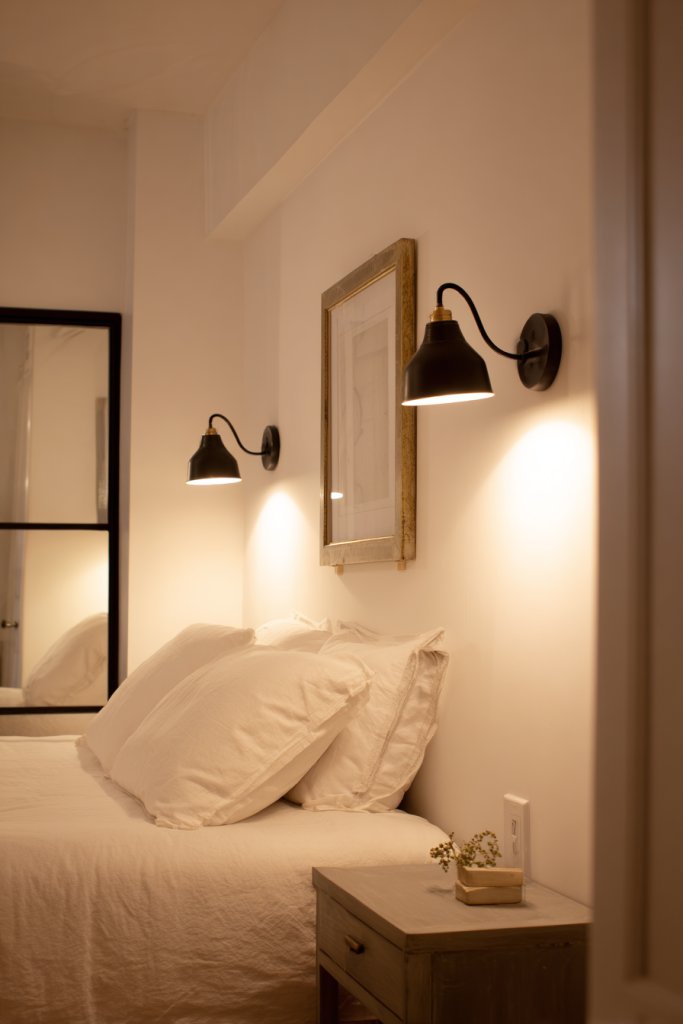
Cluttering your nightstand with lamps or relying on ceiling fixtures can make your small bedroom feel crowded. Wall-mounted lighting offers a sleek alternative that frees up precious surface space. Plus, it adds a modern, streamlined look that elevates your decor. Who knew lighting could do so much?
Envision a pair of stylish wall sconces flanking your bed, casting a warm glow without taking up any space on your bedside tables. Pendants hang from the ceiling, adding drama and functionality while keeping surfaces clear. The subtle light creates cozy zones, perfect for reading or relaxing. The minimalist design of wall-mounted fixtures complements a contemporary aesthetic perfectly.
Choose fixtures in finishes that match your decor—matte black, brushed gold, or matte white—to blend seamlessly. Adjustable sconces or flexible arms add versatility, directing light exactly where you need it. For a softer ambiance, opt for fixtures with dimming capabilities. Incorporate these lights into a layered lighting plan, combining task, ambient, and accent lighting.
Select wall-mounted fixtures that suit your room’s size and style. Ensure your walls can support the fixtures and that wiring is accessible or easy to install. Position sconces at a height that provides adequate lighting without glare—usually eye level when seated. Use dimmable bulbs for mood control. Connect the fixtures following manufacturer instructions or hire an electrician for complex setups.
Add decorative elements like fabric shades or decorative bulbs to match your room’s vibe. Install small wall-mounted shelves nearby for additional storage or decoration. Complement the lighting with textured wall coverings or paint for added depth. Swap out bulbs seasonally or for different moods—warm white for cozy nights, cooler tones for mornings.
Wall-mounted lighting not only saves space but also creates a sleek, modern atmosphere. It helps you craft a cozy retreat that feels well-designed and intentional. Once you experience the efficiency and style it brings, you’ll wonder how you ever lived without it. Brighten your space with smart, space-saving solutions!
10. Arranging Furniture for Optimal Flow and Accessibility
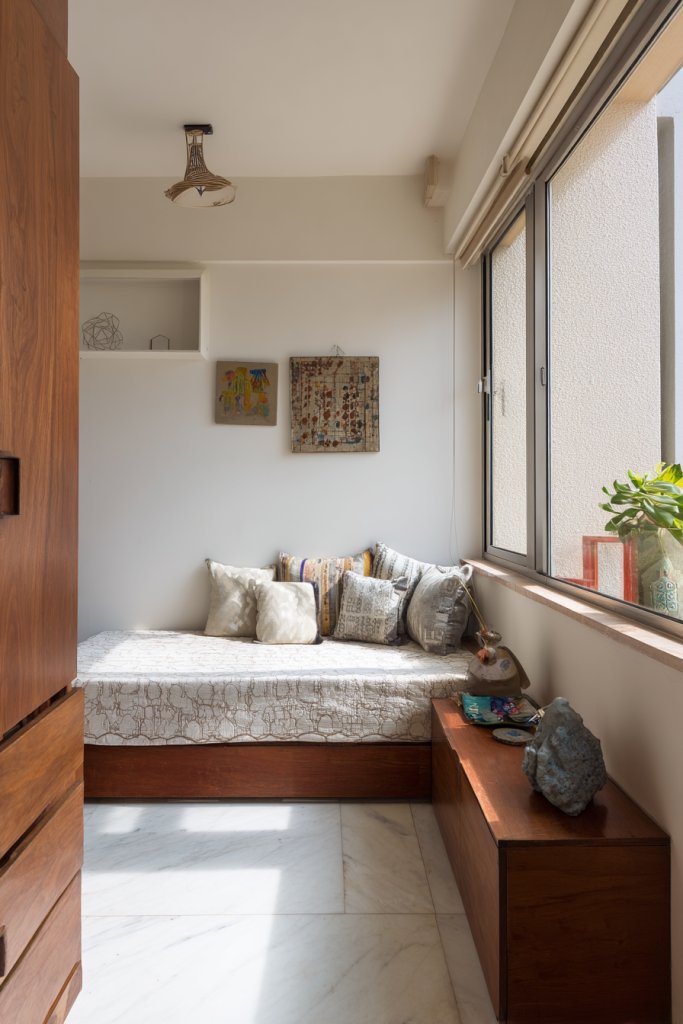
A cluttered, poorly arranged bedroom makes moving around a chore. In small spaces, every piece of furniture must be carefully placed to avoid blocking pathways or creating a cramped feel. Good layout isn’t just about aesthetics — it’s about making your room functional and comfortable.
Picture a bed pushed against one wall, leaving a clear walkway to the door and closet. A compact wardrobe or dresser fits neatly at the foot of the bed without crowding the space. Small accent chairs or side tables are positioned at angles that don’t obstruct movement. The entire room feels open, inviting, and easy to navigate.
Experiment with furniture placement based on your room’s shape—corner beds, floating layouts, or asymmetrical arrangements can work well. Use multi-use furniture like storage ottomans or foldable desks to keep pathways uncluttered. Keep larger pieces against walls, and leave the center open for movement or daily routines. Adjust seasonally, swapping furniture to suit your changing needs.
Measure your room thoroughly, noting door swings and window locations. Sketch multiple layout options before settling on the best one. Place the largest furniture items first, then fill in with smaller pieces that don’t block access. Use rugs to define zones and guide traffic flow visually. Regularly reassess your layout to improve traffic and comfort. Remember, a good flow maximizes your space’s potential.
Add decorative elements like colorful cushions or textured throws to soften the layout. Use slim-profile furniture to avoid visual bulk. Incorporate lighting that highlights pathways and zones, making navigation easier at night. Personalize with small accessories that bring joy without cluttering the space. The goal is effortless movement and a room that feels welcoming.
Thoughtful furniture arrangement transforms a small bedroom from claustrophobic to calm. It’s about creating harmony between form and function. Once you master this, your space will feel more open and relaxing, inspiring you to keep it organized. A well-placed layout is the backbone of effective small-room design—start experimenting today!
11. Incorporating Compact Desks and Work Areas in Small Rooms

Trying to work or study in a tiny bedroom? Clunky desks eat up space and can make your room feel more crowded. The solution is compact, space-saving work areas that fit seamlessly into your small sanctuary. These clever setups keep productivity high without sacrificing style.
Imagine a slim wall-mounted desk that folds down when needed and disappears when not in use. Or a corner desk that snugly fits into an unused nook, with a sleek chair tucked underneath. This setup leaves room for movement and relaxation, while still giving you a dedicated workspace. Bright lighting and minimal decor keep the area functional and inviting.
Choose fold-away or extendable desks that suit your daily needs. Use floating shelves above the workspace for supplies or decorative touches. For a minimalist look, opt for a single, slim desk with hidden storage compartments. Incorporate comfortable, ergonomic chairs that don’t overwhelm the space. Adapt the setup seasonally with accessories or color schemes.
Measure available wall or corner space to select the right-sized desk. Install wall-mounted or fold-down desks that lock securely in place. Use lightweight, multi-purpose furniture to maximize flexibility. Keep cords and chargers organized with cable clips or small baskets. Add a comfortable chair that can slide completely underneath to save space. Regular tidying ensures the area remains clutter-free.
Decorate with stylish desk accessories, colorful stationery, or small potted plants (avoiding restricted content). Use a patterned or textured rug underneath to anchor the space visually. Incorporate task lighting like clip-on lamps or LED strips for focused illumination. Personal touches like framed quotes or artwork make the area inspiring and uniquely yours.
A small, well-designed workspace boosts your productivity and keeps your room feeling spacious. It’s proof that even tiny rooms can be functional and stylish. When you see how easily you can create a dedicated zone, you’ll be motivated to keep it organized and inviting. Your perfect mini-office is within reach!
12. Using Clear or Transparent Furniture for a Less Cluttered Look
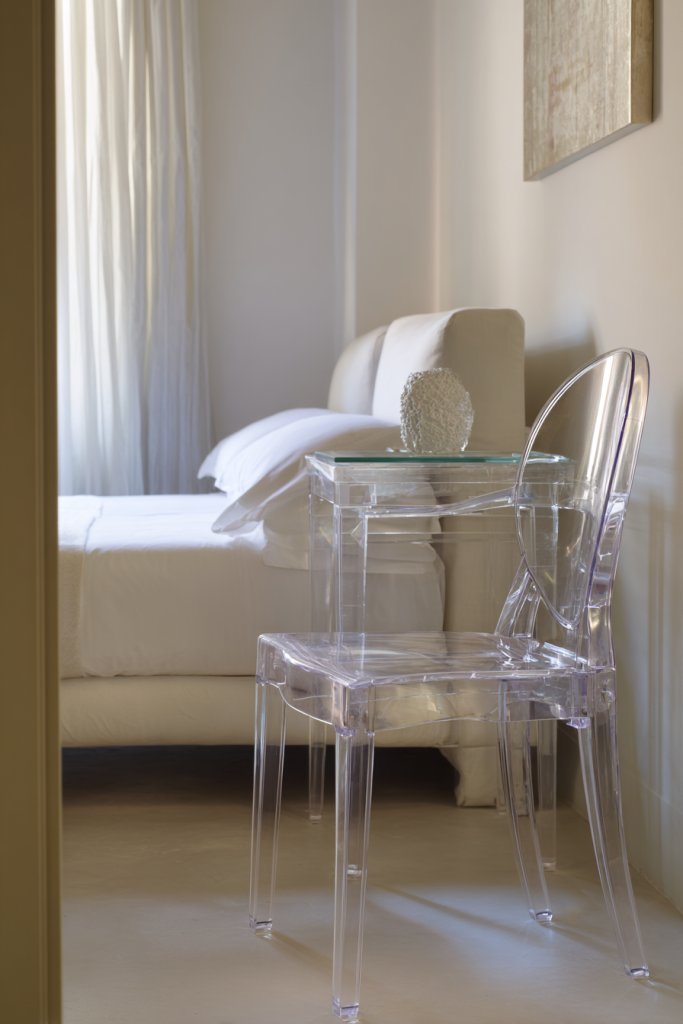
Clutter can make even the biggest rooms feel cramped, especially when bulky furniture blocks the visual flow. Clear or transparent furniture, like acrylic tables and chairs, offers a sleek solution that helps your space breathe. It’s an easy way to make your tiny bedroom feel more open and less crowded.
Picture a transparent acrylic side table beside your bed, with a simple lamp on top. A clear chair doubles as a desk or seating without adding visual weight. The see-through quality allows your eye to travel freely around the room, creating an illusion of more space. Light bounces off the surfaces, brightening the room and enhancing the minimalist aesthetic.
Choose furniture with sleek, modern lines in acrylic or tempered glass for a contemporary look. Mix transparent pieces with light-colored textiles and soft accents to prevent the space from feeling cold. Use small, clear storage containers or trays to keep clutter out of sight while maintaining a clean look. This approach suits minimalist, Scandinavian, or modern interiors.
Select transparent furniture that is sturdy and easy to clean. Place larger pieces like a see-through desk or side table strategically to maximize openness. Combine with soft textiles to add warmth and texture. Keep surfaces clutter-free, storing items in hidden compartments or drawers. Regularly wipe down glass or acrylic to maintain clarity and shine.
Decorate with colorful throws, textured pillows, or small vibrant accessories that pop against the clear furniture. Use subtle lighting—like LED strips—to give depth and highlight the furniture’s transparency. Incorporate decorative trays or dishes made of glass or acrylic for jewelry or keys. Personal touches like framed photos or small sculptures can add personality without visual clutter.
Using transparent furniture is a simple, stylish way to open up your small space. It’s a smart choice that makes your room look bigger and brighter instantly. Once you see how much more spacious your bedroom feels, you’ll be inspired to keep it clutter-free and modern. Less visual weight equals more room for your personality!
13. Embracing Minimalist Decor to Enhance Spaciousness

Too many decorative items can make your small bedroom look cluttered and chaotic. Embracing minimalist decor strips away unnecessary clutter and creates a calming, spacious atmosphere. It’s about focusing on quality over quantity and letting your space breathe. Less truly is more.
Imagine a room with a simple platform bed, a couple of sleek nightstands, and a few carefully chosen accessories. Neutral tones dominate, with a single large mirror or artwork as a statement piece. The clean lines and open surfaces draw your eye outward, making the room feel larger than it is. Textures are subtle but add depth without overwhelming.
Choose furniture with clean, simple lines—think Scandinavian or contemporary styles. Limit your color palette to monochrome or soft neutrals, adding a splash of color sparingly. Use hidden storage solutions to keep surfaces clear. Seasonal changes can be incorporated with different textiles or small accent pieces, always maintaining the minimalist ethos.
Start by decluttering—remove anything that doesn’t serve a purpose or bring joy. Invest in quality, multi-use pieces that combine function and style. Keep surfaces free of excess decor; opt for a few curated items like a single vase or a small sculpture. Use hidden compartments or storage beds to hide away seasonal items. Regularly reassess to ensure the space remains simple and serene.
Add personality with textured textiles like a cozy throw or subtle patterned bedding. Incorporate a few personal mementos that don’t clutter surfaces, such as a framed photo or a special keepsake. Use lighting to create ambiance—think warm, dimmable bulbs or hidden LED strips. The goal is a peaceful, clutter-free sanctuary.
Minimalist decor isn’t just trendy—it’s transformative. It clears your mind as well as your space, making your small bedroom feel larger and more peaceful. Once you experience the calm of minimalist design, you’ll be motivated to keep your space simple and stylish. Less clutter, more serenity—that’s the minimalist promise.
14. Creating a Focal Point with a Statement Headboard or Wall Feature

Small bedrooms often lack a central feature that draws the eye and adds personality. A bold headboard or wall feature creates an instant focal point that elevates the entire room. It’s a simple upgrade that adds drama and style without taking up extra space. Want to make your bedroom stand out?
Picture a textured fabric headboard in a deep jewel tone, contrasting with light walls and bedding. Alternatively, a statement wall with textured wallpaper or geometric wall panels transforms a plain space into a visual masterpiece. The feature anchors the room and guides your eye, making the space feel intentional and curated. It’s a game-changer for small rooms.
Choose a headboard in bold colors, rich fabrics, or textured materials to suit your style—boho, modern, or classic. Wall features can include statement paint, decorative panels, or geometric tiles. Keep surrounding decor minimal to let the feature shine. For versatility, opt for removable or peel-and-stick wall coverings that won’t damage paint.
Select a headboard or wall feature that complements your room’s size and style. Install securely, ensuring it’s centered and at a comfortable height. Keep other elements simple—neutral bedding, minimal decor—to highlight the feature. Use lighting to accentuate textures or colors, like wall sconces or directed spotlights. Regularly maintain and clean the feature for lasting impact.
Decorate around the feature with subtle textiles or small decorative objects. Incorporate artwork or framed photos that coordinate with the wall feature’s style. Use lighting creatively—like uplights or LED strips—to add depth and drama. Change out accessories seasonally for a fresh look that keeps the room feeling vibrant.
A statement headboard or wall feature instantly elevates your small bedroom from basic to beautiful. It’s an affordable way to add personality and style without overwhelming the space. Once you see how a single feature transforms the entire room, you’ll feel inspired to get creative with other design elements. Make a statement—your room deserves it!
15. Incorporating Niche Shelves and Hidden Storage Solutions

Tiny bedrooms are notorious for clutter, but clever storage can free up space and keep things out of sight. Niche shelves and hidden compartments are perfect for maximizing every inch without adding bulk. It’s a smart way to keep your room organized and looking sleek.
Imagine slim niche shelves built into the wall behind your bed, holding favorite books, small decor, or essential items. Hidden drawers or compartments tuck away seasonal clothes or accessories, keeping surfaces clear. These discreet storage solutions blend seamlessly into your decor, maintaining a clean, streamlined look. The result is a room that feels spacious and well-organized.
Choose recessed shelves with minimalist finishes for a modern vibe or decorative niches with textured backs for visual interest. Hidden storage can be integrated into headboards, under stairs, or within furniture pieces. Incorporate these in every room corner—above doors, beneath windows—to save space. The key is blending function with aesthetic appeal.
Plan your wall layouts carefully, marking where niches or hidden drawers can be installed. Use lightweight, durable materials for shelves—wood, MDF, or plywood—painted or finished to match your decor. Secure all elements properly to avoid accidents or damage. Keep access simple and consider a mix of open and concealed storage for versatility. Regularly check for dust or wear.
Decorate niches with textured wallpaper or paint in contrasting colors for visual interest. Use small baskets or fabric-lined boxes inside hidden compartments for organization. Incorporate LED lighting inside niches or drawers to highlight their contents and add ambiance. Personalize with small mementos or favorite items in visible niches.
Niche shelves and hidden storage turn your small bedroom into a clutter-free oasis. They maximize space while keeping your room stylish and functional. Once you see how these clever solutions work, you’ll be motivated to find even more ways to optimize your space. Small rooms can be big on smart storage!
16. Choosing Low-Profile Furniture for a Sleek, Unobtrusive Look
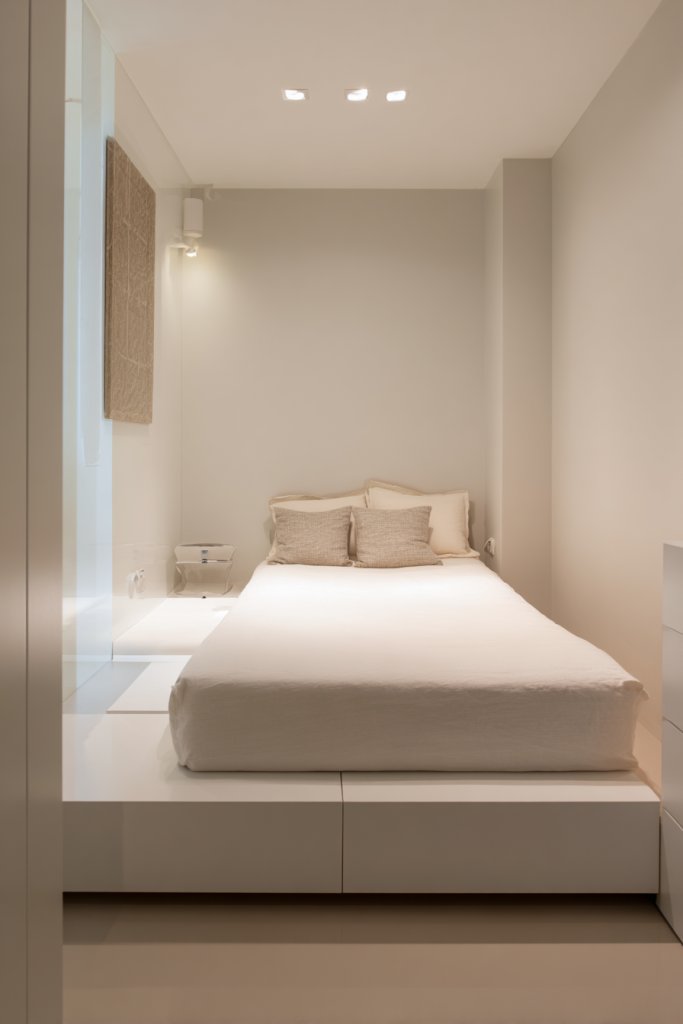
Bulky furniture can make a tiny bedroom feel even smaller and more cluttered. Low-profile furniture offers a sleek alternative that enhances the sense of space. It creates clean lines and visual openness, making your small room appear larger and more modern.
Picture a bed with a slim, minimalist frame that sits just above the floor, paired with a low dresser and petite side tables. The absence of tall headboards or bulky legs keeps sightlines open and gives the room a calm, uncluttered feel. The furniture’s simple design allows the focus to be on the space and light rather than heavy pieces.
Select furniture with slim profiles, rounded edges, and minimal hardware. Natural wood finishes or matte paints work well for a modern, Scandinavian vibe. Keep accessories minimal—think sleek baskets or compact storage to avoid visual clutter. This approach suits both contemporary and minimalist styles, easily blending into any decor.
Measure your space carefully and select furniture designed with low profiles—generally under 18 inches tall. Avoid overstuffed pieces; instead, choose multi-use or modular items. Position larger pieces against the walls, leaving the center open. Use light-colored textiles and surfaces to amplify the airy feel. Regularly reassess and declutter to maintain the sleek look.
Add subtle decorative touches like textured throws, small artwork, or decorative hardware that complements the low-profile aesthetic. Incorporate lighting that emphasizes the furniture’s clean lines, such as wall sconces or recessed lights. Use minimalistic accessories that serve a purpose, keeping surfaces free of excess. Personalize with small details that reflect your style.
Low-profile furniture combines style and practicality, transforming your small bedroom into a sleek retreat. It’s a simple yet effective way to make your space feel more open and inviting. Once you experience the spaciousness it creates, you’ll be inspired to keep your decor minimal and intentional. Small space? Big style!
17. Using Rugs and Floor Coverings to Define Spaces and Add Warmth
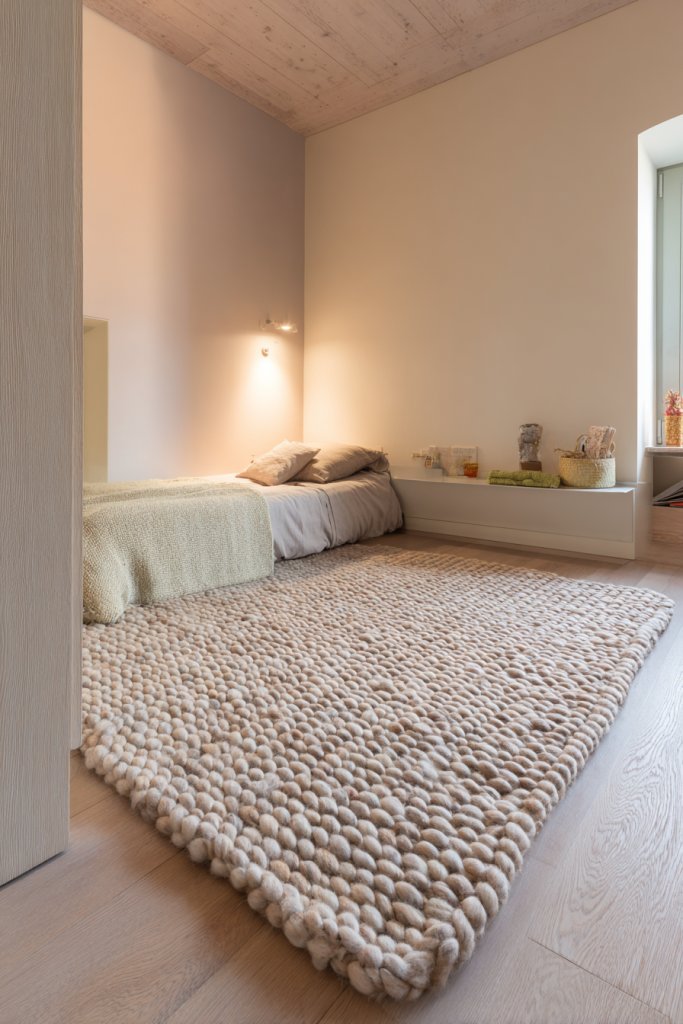
A small bedroom can feel cold and disconnected without proper zoning. Rugs and floor coverings are an easy fix to define areas and add warmth. They create visual separation and comfort, making your tiny space feel more inviting and organized.
Imagine a plush, neutral-toned rug anchoring your bed area with a softer, textured runner beside it. A smaller, patterned rug delineates your workspace or reading nook, adding personality. The combination of different textures and colors creates a layered, cozy atmosphere. Rugs also absorb sound, reducing echo in small rooms, and make the space feel more tactile.
Choose rugs in colors that complement your walls and furniture. Layer rugs for visual interest or keep it simple with one large piece. In small rooms, opt for smaller, strategically placed rugs rather than overwhelming the floor. Use textured or patterned rugs to hide stains or wear, and select easy-to-clean materials for practicality.
Measure your floor space carefully to select appropriately sized rugs. Position the main rug under your bed, extending beyond the edges for a balanced look. Use smaller rugs to mark zones—near a reading chair or workspace—without cluttering the entire floor. Secure rugs with non-slip pads to prevent slipping and bunching. Regular cleaning keeps them fresh and inviting.
Incorporate colorful or textured rugs that reflect your personality. Add cozy textiles like throws or cushions to enhance comfort. Use rugs to introduce seasonal color changes or patterns, keeping your room lively and fresh. Pair with lighting that highlights the textures and colors for a warm, inviting ambiance.
Rugs and floor coverings are affordable, versatile tools to make your small bedroom feel larger and more comfortable. They define zones, add warmth, and elevate your decor with minimal effort. Once you see how a simple rug changes the room’s vibe, you’ll be motivated to keep your space cozy and stylish. Comfort meets style—perfect!
18. Creating a Double-Duty Closet with Sliding Doors

A cluttered or bulky wardrobe can eat up precious space in a small bedroom. Sliding closet doors offer a sleek, space-saving solution that keeps your wardrobe out of sight and your room feeling open. It’s the perfect way to hide your clutter and keep your decor streamlined.
Imagine a built-in closet with smooth, white sliding doors that glide effortlessly open. When closed, they create a clean, minimalist look that blends with your walls. The sliding mechanism eliminates the need for clearance space, making the room feel larger. Inside, organized shelves and hanging spaces keep everything tidy and accessible.
Choose from mirrored sliding doors to add a functional mirror or opaque panels for a sleek look. For a more personalized touch, opt for doors with textured finishes or bold colors to add visual interest. Incorporate soft-close mechanisms for quiet operation and durability. Use inside organizers—pull-out baskets, dividers, or shoe racks—to maximize every inch.
Assess your closet dimensions and select sliding doors that fit comfortably. Install sturdy tracks and ensure smooth operation—professional help might be worth it for a perfect fit. Use the interior space efficiently with adjustable shelving and hanging rods. Keep the exterior simple and clutter-free, enhancing the room’s clean aesthetic. Regular maintenance ensures smooth sliding.
Decorate the outside of your closet with decorative panels, decals, or paint to match your room’s style. Use inside storage solutions to keep everything organized—labeled bins or pull-out drawers. Incorporate lighting inside the closet for easy access and visibility. Personal touches like patterned or textured doors can add character.
A double-duty closet with sliding doors transforms your bedroom into a sleek, organized retreat. It maximizes storage while keeping clutter hidden, making your room appear larger. Once you experience the benefits, you’ll wonder how you ever managed without sliding doors. Style, function, and space—done right!
19. Implementing Smart Storage Behind Doors and in Corners
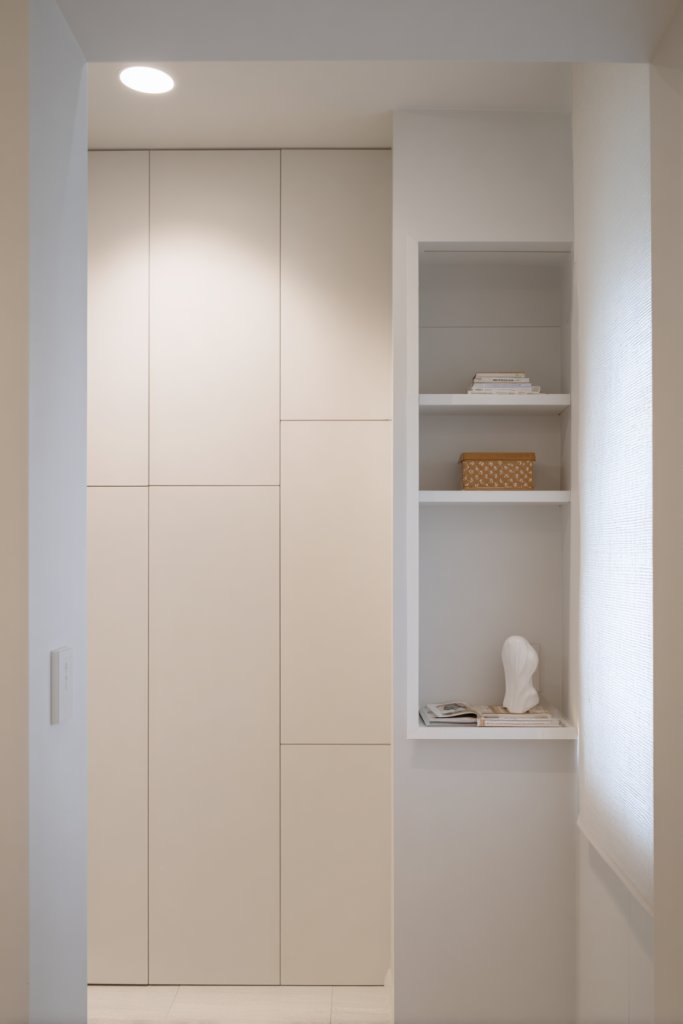
Small bedrooms often have tricky corners or hidden spots where clutter accumulates. Smart storage solutions behind doors or tucked into corners turn wasted space into practical storage. It’s a clever way to keep your room tidy without sacrificing style or space. Who knew corners could be so useful?
Visualize over-the-door organizers holding shoes, accessories, or small essentials, freeing up drawers and shelves. Corner shelves or cabinets neatly tuck into awkward spaces, providing extra storage without protruding into the room. These solutions keep everything accessible yet hidden, maintaining a clean look. It’s like having a secret storage vault right in plain sight.
Choose slim, adjustable racks or baskets that can hang or slide into place. Use fabric or mesh organizers to keep items visible and accessible. For doors, install hooks, pockets, or racks that won’t damage paint or surfaces. Adapt to your needs by customizing the size and configuration of these hidden solutions. It’s all about making your small space work smarter.
Identify areas where clutter piles up—behind doors, under beds, or in corners. Install over-the-door hooks or racks that support weight and durability. Use corner shelves or cabinets with adjustable or removable components for flexibility. Keep frequently used items at eye level for easy access. Regularly declutter to prevent hidden storage from becoming a catch-all.
Decorate hidden storage with matching paint or wallpaper for a seamless look. Use labeled baskets or boxes for organized grouping. Incorporate LED or battery-operated lights inside cabinets or behind doors to improve visibility. Personalize with decorative touches that complement your room’s style, making hidden storage both functional and attractive.
Smart storage behind doors and in corners maximizes every inch of your small bedroom. It keeps clutter out of sight and your space looking fresh and organized. Once you see how much you can hide away, you’ll be motivated to keep everything in its place. Small space? Big potential.
20. Opting for Vertical Wall Hooks and Pegboards for Organization
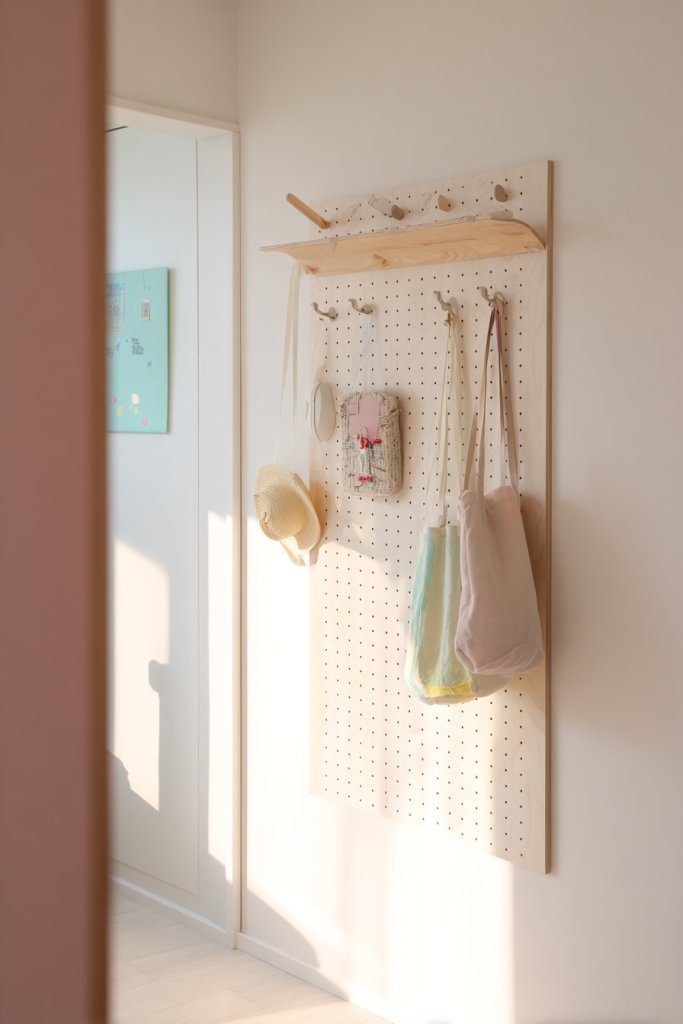
Tangled cords, scattered accessories, or clothing piling up? Vertical wall hooks and pegboards are game changers for small bedrooms. They keep essentials within reach and off surfaces, creating a tidy, visually appealing space. Plus, they add an industrial or modern touch to your decor.
Picture a pegboard above your desk holding office supplies, jewelry, or small decor pieces. Vertical hooks support hats, bags, or scarves, freeing dresser space. The perforated surface allows for flexible arrangement, making it easy to customize as your needs change. It’s a practical, stylish way to organize and display essentials.
Choose from metal, wood, or plastic pegboards in various colors and patterns. Use hooks, baskets, or clips to organize different items. Incorporate small shelves or cubbies for added storage. Position these elements at accessible heights for daily use. Adapt to your decor style—industrial, boho, or minimalist—by selecting finishes and accessories accordingly.
Attach pegboards securely to wall studs or anchors, ensuring they support weight. Arrange hooks and shelves in a way that maintains easy access and visual balance. Use labels or color coding to keep things organized. Keep cords and wires tidy with clips or sleeves. Regularly reassess and update your setup for optimal organization.
Decorate pegboards with themed accessories, decorative tape, or paint for a personalized look. Use colorful or patterned hooks and baskets to add pops of color. Incorporate small plants or lights, avoiding restricted content, to make the space lively. Change the arrangement seasonally or as your needs evolve.
Vertical hooks and pegboards turn cluttered chaos into organized bliss. They’re simple, customizable, and space-efficient. Once you see how easily they keep your essentials in order, you’ll be motivated to keep your room tidy. Small space? Big organization potential!
21. Choosing a Monochrome or Cohesive Color Scheme for a Seamless Look
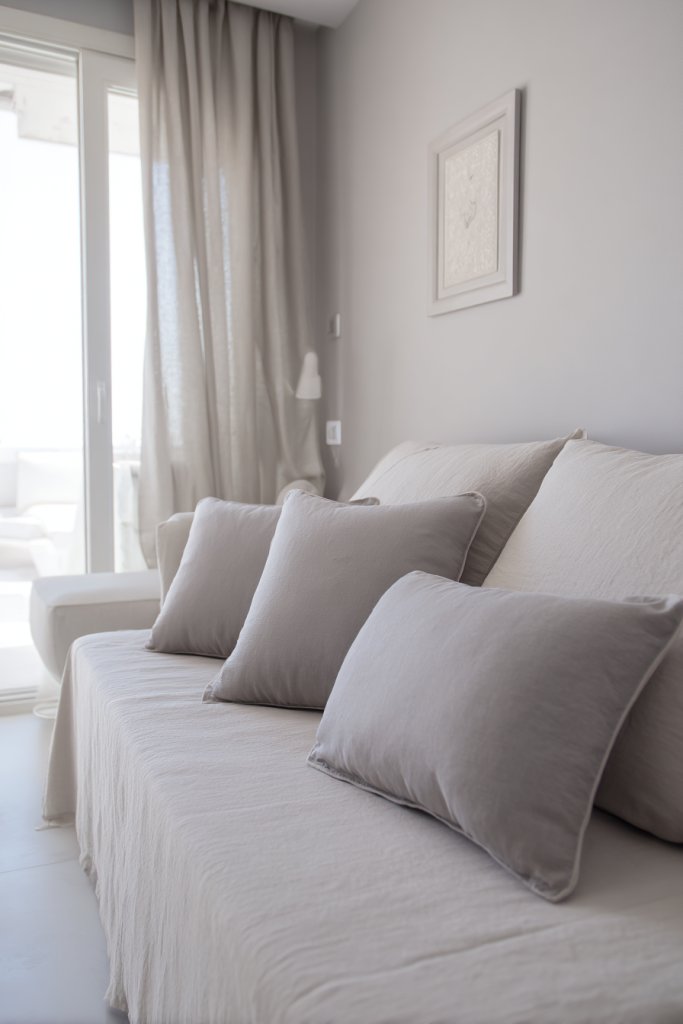
A cluttered, mismatched room can feel chaotic and small. Opting for a monochrome or cohesive color scheme creates a unified look that visually expands your space. It’s a simple trick that instantly makes your tiny bedroom feel bigger, calmer, and more organized. Ready for a room that looks effortlessly put together?
Imagine walls, bedding, and furniture all in shades of soft gray or beige, with subtle variations in texture. This seamless palette allows your eye to flow smoothly across the room without interruption. Add interest with different textures—like matte, gloss, or woven finishes—while keeping the color consistent. The overall effect is a calm, spacious retreat that feels intentional and stylish.
Choose a color scheme that suits your personality—cool tones for tranquility, warm hues for coziness. Incorporate accent pieces like cushions, throws, or small decor items in complementary shades to add depth. Use monochrome patterns or subtle contrasts to prevent visual monotony. This approach can be adapted seasonally by swapping textiles or accessories.
Start by selecting a dominant color and building your palette around it. Use this color for walls, bedding, and major furniture pieces. Keep smaller accessories within the same range of shades for harmony. Incorporate different textures and finishes to add dimension. Avoid mixing too many colors or patterns that can break the seamless look. Regularly reassess to maintain cohesion.
Personalize with textured textiles, such as a chunky knit blanket or velvet cushions, in your chosen color scheme. Add personal touches like framed photos or artwork that complement the palette. Use lighting—warm or cool—to enhance the overall tone and mood. This consistency makes your room feel curated and spacious.
A cohesive color scheme simplifies decorating and transforms your small bedroom into a harmonious sanctuary. It’s a timeless approach that never goes out of style and instantly adds a layer of sophistication. Once you embrace a unified look, you’ll find it easier to keep your space organized and beautiful. Style made simple!
Conclusion
With a diverse range of small bedroom layout ideas, you now have the tools to turn your compact space into a beautiful, efficient retreat. Experiment with different arrangements and design tricks to find what works best for you. Embrace these ideas and take the leap toward a more organized and inspiring bedroom—your ideal cozy haven awaits!